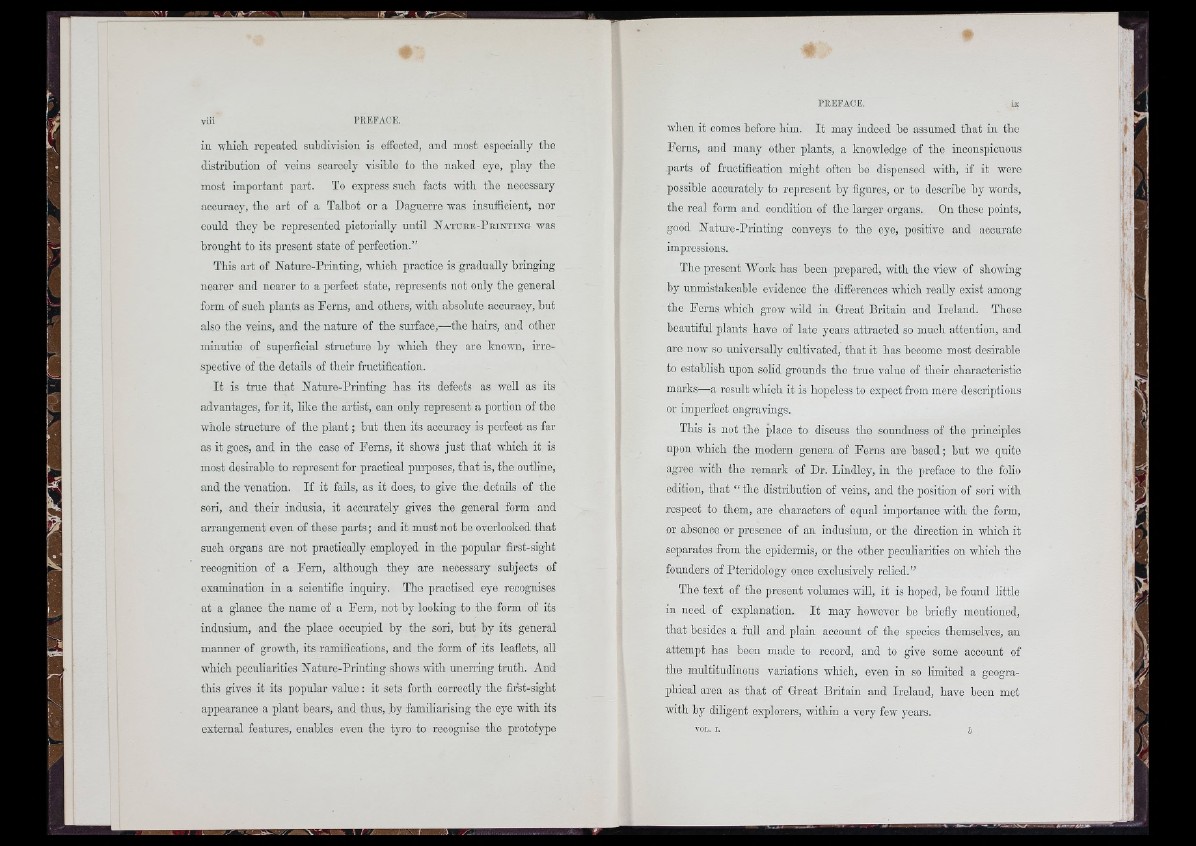
v iü PIÎEFACE.
in wMoli l'cpoatod subdivision is effected, and most especially tbe
distribution of veins scarcely visible to tbo naked eye, play tlio
most important part. To express such facts with the necessary
accuracy, the art of a Talbot or a Daguerre was insufficient, nor
could they bo represented pictorially until N a t u r e - P r i n t i n g was
brought to its present state of perfection.”
This art of Nature-Printing, which practice is gradually bringing
nearer and nearer to a perfect state, represents not only the general
form of such plants as Ferns, and others, with absolute accuracy, but
also the veins, and the nature of the surface,—the hairs, and other
minutiæ of superficial structure by which they are known, irrespective
of the details of their fructification.
I t is true that Nature-Printing has its defects as -well as its
advantages, for it, like the artist, can only represent a portion of the
whole structure of the plant ; hut then its aocuraoy is perfect as far
as it goes, and in the case of Ferns, it shows just that which it is
most desirable to represent for practical purposes, that is, the outKuc,
and the venation. I f it fails, as it does, to give the details of the
sori, and their indusia, it accurately gives the general form and
arrangement even of these parts; and it must not ho overlooked th a t
such organs are not practically employed in the popular first-sight
recognition of a Fern, although they are necessary subjects of
examination in a scientific inquiry. The practised eye recognises
at a glance the name of a Fern, not by looking to the form of its
indusium, and the place occupied by the sori, but by its general
manner of growth, its ramifications, and the form of its leaflets, all
which peculiarities Nature-Printing shows with unerring truth. And
this gives it its popular value : it sets forth correctly the first-sight
appoaranoe a plant bears, and thus, by familiarising tbo eye with its
external features, enables even the tyro to recognise the prototype
I ’KEEACE, ix
when it comes before him. I t may indeed he assumed that in the
Ferns, and many other plants, a knowledge of the inconspicuous
parts of fructification might often ho dispensed with, if it wore
possible accurately to represent by figures, or to describe by words,
the real form and condition of the larger organs. On those points,
good Nature-Printing conveys to the eye, positive and accurate
impressions.
The present Work has been prepared, with the view of showing
by unmistakeahle ovidonco the differences which really exist among
the Ferns which grow wild in Great Britain and Ireland. These
beautiful plants have of late years attracted so much attention, and
are now so universally cultivated, th a t it has become most desirable
to establish upon soUd grounds the true value of their oharaoteristio
marks—a result which it is hopeless to expect from more descriptions
or imperfect engravings.
This is not the place to discuss the soundness of the prlnoiplos
upon which the modern genera of Ferns arc based; but we quite
agree witli the remark of Dr. Bindley, in the preface to the folio
edition, th a t “ the distribution of veins, and the position of sori with
respect to them, are characters of equal importance with the form,
or absence or presence of an indusium, or tho direction in which it
separates from the epidermis, or tho other peculiarities on which tho
founders of Pteridology once exclusively relied.”
The text of the present volumes will, it is hoped, be found littlo
in need of explanation. I t may however bo briefly mentioned,
th a t be,sides a fuR and plain account of the species themselves, an
attemj)t has been made to record, and to give some account of
the multitudinous variations which, oven in so limited a geographical
area as that of Groat Britain and Ireland, have boon met
with by diligent explorers, within a very few years.